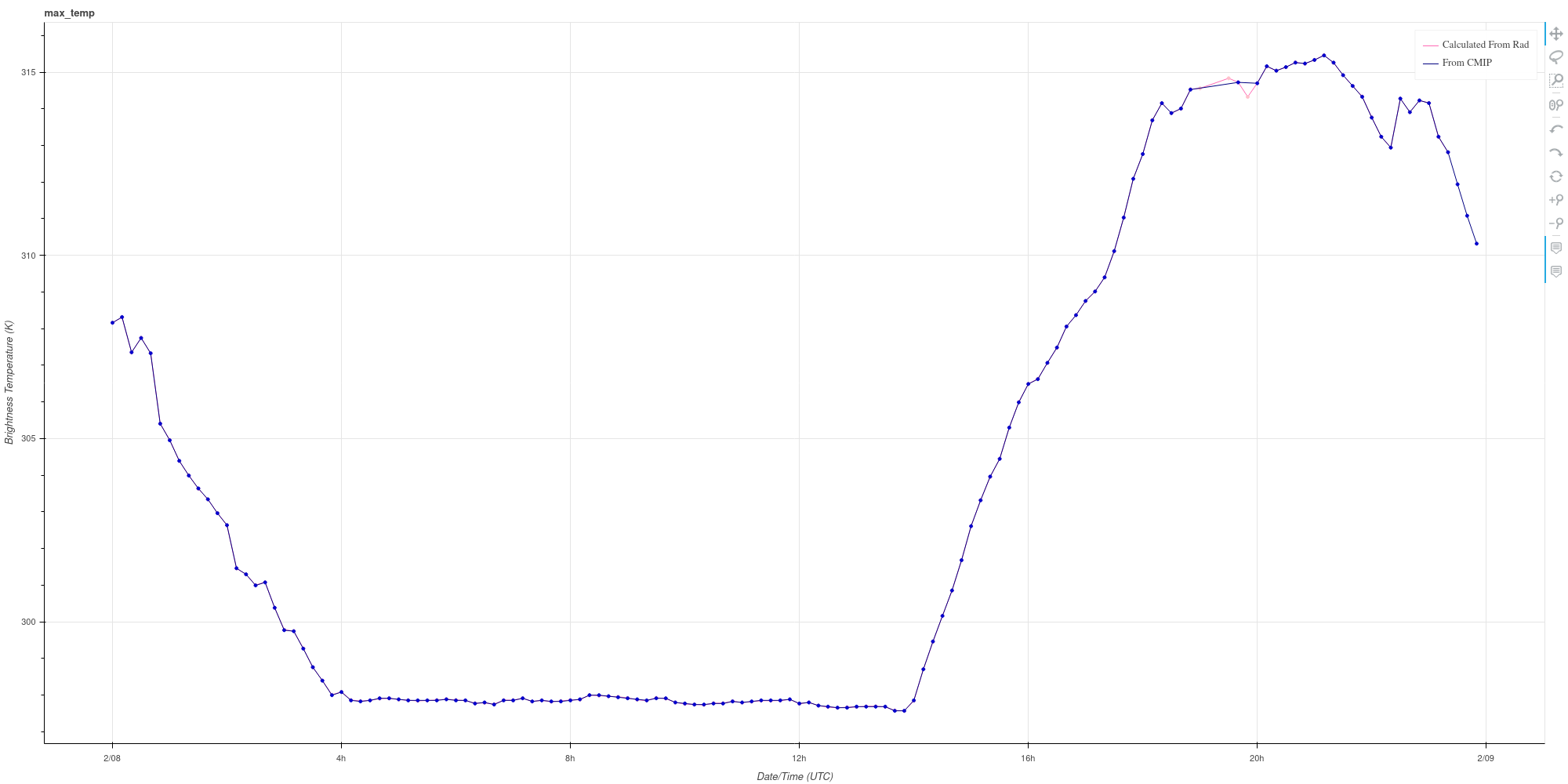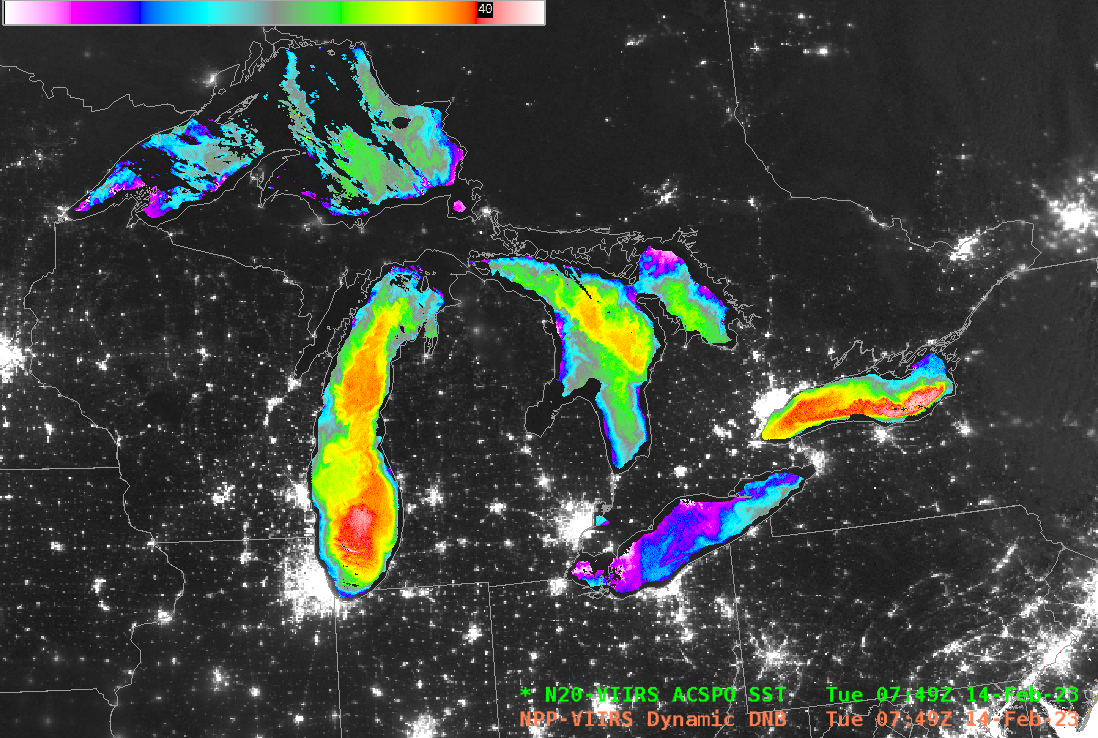
[ Archive ]

 |
CIMSS-NOAA Weekly Report [ Archive ] |
 |
CIMSS AND ASPB WEEKLY HIGHLIGHTS FOR THE WEEK ENDING FEBRUARY 17, 2023
DATA, INFORMATION, AND USE-INSPIRED SCIENCE:
CIMSS Releases ABI Imagery File Monitoring Webpage: Researchers at the Cooperative Institute for Meteorological Satellite Studies have released a web page that monitors the metadata from GOES-R series Advanced Baseline Imager (ABI) radiance and Cloud and Moisture Imagery Product (CMIP) files, meeting a STAR milestone. Specifically, the mean, minimum, maximum, and standard deviation of the radiances and CMI values (reflectance factor for the reflective visible and near-infrared bands or brightness temperatures for the emissive infrared bands) are plotted as a time-series. Users can choose date ranges, satellite (GOES-16, -17, or -18), sector (Full Disk, CONUS, Mesoscale1, or Mesoscale2), and what product to view. Products can be CMI from CMIP files, CMI as calculated from radiance files, or the difference of those two or comparison of those two, as well as radiances from the radiance files. This web-tool was designed by a University of Wisconsin-Madison Space Science & Engineering Center (SSEC) undergraduate summer intern student to help monitor CMIP quality: https://cimss.ssec.wisc.edu/goes-r/abi-/cmip_stats. (M. Gunshor, CIMSS, matg@ssec.wisc.edu, T. Schmit, E/RA2, 608-263-0291, tim.j.schmit@noaa.gov, J. Nelson, CIMSS, M. Suzuki, CIMSS)
 (Click image to enlarge)
(Click image to enlarge)
Figure: Caption: GOES-18 ABI full disk maximum brightness temperatures, band 13 (10.35um) for February 8, 2023 from the Level 2 Cloud and Moisture Imagery Product (CMIP) file (blue) and calculated from the Level 1b radiance file mean maximum radiance from https://cimss.ssec.wisc.edu/goes-r/abi-/cmip_stats.
SSEC ingests and provides GOES-17 ABI test data to STAR: The Satellite Data Services (SDS) team at the University of Wisconsin-Madison's Space Science & Engineering Center (SSEC) are ingesting GOES-17 GOES ReBroadcast (GRB) data while it is being tested at its storage location of 104.7 West. SSEC is using a 4.5 meter antenna to bring in GRB, assembling the level-1b (L1b) data files, and archiving the data. In addition, the data are being provided to NOAA/NESDIS/STAR for level 2 algorithm, and other, testing purposes. GOES-R Algorithm Working Group (AWG) and Calibration Working Group (CWG) have been notified. (J. Robaidek, SSEC, 608-262-6025, M. Gunshor, CIMSS, matg@ssec.wisc.edu, T. Schmit, E/RA2, 608-263-0291, tim.j.schmit@noaa.gov)
(Click image to enlarge)
Figure: The first GOES-17 Full Disk (FD) Advanced Baseline Imager (ABI) band 13 (10.3um) image from the storage location of 105W at 20:10 UTC on 10 Feb 2023.
FUTURE OUTLOOK:
AWARDS AND RECOGNITION:
TRAVEL AND MEETINGS:
CIMSS participation in MENA region panel discussion on water issues: William Straka participated as a panelist at the Middle East Institute’s discussion on “Tracking Water Resources from Space: Challenges and Targeted Solutions for the Middle East and North Africa (MENA) Region” at the request of the WMO Satellite Services division. There was a lot of engagement between the panelists on a wide set of wide ranging questions regarding how satellites and remote sensing can be used to track water resources, specifically in the MENA region. This included discussion about capacity gaps and usage of public and private satellite and remote sensing data to help address water resource monitoring and disaster response in the MENA and other regions. A link to the discussion can be found at https://www.youtube.com/watch?v=0z96WDxJL7g. (W. Straka III, CIMSS)
TRAINING AND EDUCATION:
MEDIA INTERACTIONS AND REQUESTS:
SOCIAL MEDIA AND BLOG Posts:
SSEC and CIMSS Scientists in the News: Scientists at the University of Wisconsin-Madison (UW) Space Science and Engineering Center (SSEC) and the Cooperative Institute for Meteorological Satellite Studies (CIMSS) provide expert interviews, imagery and case studies to promote science. This week: 1) A recent study led by Margaret Mooney, director of education and public outreach at CIMSS and UW–Madison adjunct professor, investigated climate education and the connection between knowledge gains and behavior change. SSEC News published this story: https://www.ssec.wisc.edu/news/articles/14992/. 2) CIMSS Satellite Blog contributors Margaret Mooney, Scott Lindstrom and Scott Bachmeier published these case studies: "NOAA-21 sends data to Earth" (Feb. 16), :"More SAR data over Cyclone Freddy, and parallax" (Feb. 16), "Cyclone Freddy intensifies to a Category 5 storm" (Feb. 15), "Mid-February view of Lake Erie" (Feb. 14), "Strong winds causing heavy freezing spray off the Alaska coast" (Feb. 12), "Sentinel 1A SAR winds near American Samoa on 11 February 2023" (Feb. 12) and "Cyclone Freddy reaches Category 4 intensity" (Feb. 11). Read more at the CIMSS Satellite Blog: https://cimss.ssec.wisc.edu/satellite-blog/. (M. Mooney, CIMSS, E. Verbeten, SSEC, S. Lindstrom, CIMSS, S. Bachmeier, CIMSS, J. Phillips, SSEC, 608-262-8164)
 (Click image to enlarge)
(Click image to enlarge)
Figure: NOAA Advanced Clear-Sky Processor for Ocean (ACSPO) Sea Surface Temperatures (SSTs) along with VIIRS Day Night Band imagery of the Great Lakes on Feb. 14, 2023. Read more at the CIMSS Satellite Blog: https://cimss.ssec.wisc.edu/satellite-blog/archives/50466. Credit: NOAA, CIMSS.
PUBLICATIONS:
OTHER:
| Archived Weeklies Page | Submit a report item |